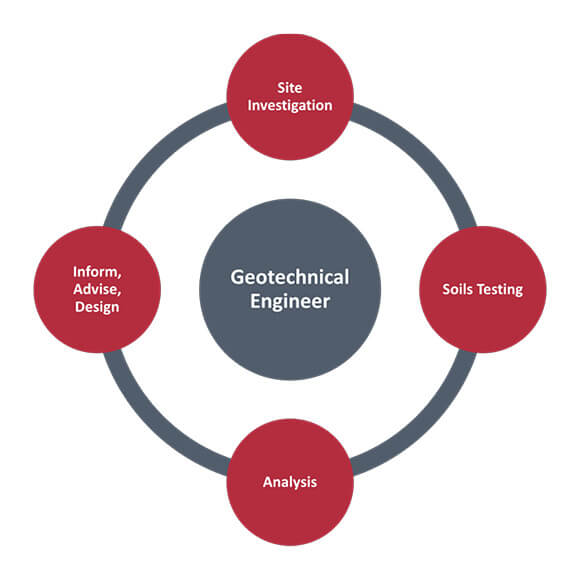The 6-Minute Rule for Geotheta
The 6-Minute Rule for Geotheta
Blog Article
Fascination About Geotheta
Table of ContentsThe Basic Principles Of Geotheta Excitement About Geotheta7 Simple Techniques For GeothetaThe Definitive Guide to Geotheta9 Easy Facts About Geotheta Shown

They conduct site examinations, collect samples, execute laboratory tests, and assess information to assess the viability of the ground for building projects - Engineer of Record. Based upon their findings, geotechnical engineers offer recommendations for structure design, slope security, preserving structures, and mitigation of geotechnical hazards. They collaborate with other professionals, such as engineers, architectural designers, and building and construction groups, to make sure that geotechnical considerations are incorporated into the total task style and implementation
By assessing the behavior and properties of dirt and rock, they can determine possible geotechnical risks such as landslides, soil negotiation, or incline instability. Their expertise helps avoid failures or mishaps that can endanger lives and home. Here are some in-depth responsibilities and responsibilities of a geotechnical designer: Site Examination: Geotechnical designers conduct website examinations to gather data on subsurface problems.
They interpret the information to comprehend the buildings and behavior of the dirt and rock, including their strength, leaks in the structure, compaction qualities, and groundwater conditions. Geotechnical Evaluation and Style: Geotechnical engineers assess the information gathered during website examinations to evaluate the stability and suitability of the site for construction projects. They perform geotechnical estimations and modeling to evaluate variables such as bearing capacity, negotiation, slope security, side planet stress, and groundwater flow.
Not known Incorrect Statements About Geotheta
Structure Design: Geotechnical engineers play a vital role in designing structures that can safely support the intended framework. They evaluate the dirt conditions and lots requirements to determine the suitable structure type, such as shallow structures (e.g., footings), deep structures (e.g (https://www.anyflip.com/homepage/zuylo)., stacks), or specialized methods like soil enhancement. They take into consideration variables such as settlement restrictions, bearing capability, and soil-structure interaction to develop optimal foundation designs
They review building and construction plans, display website tasks, and conduct area evaluations to confirm that the style suggestions are followed. If unanticipated geotechnical concerns occur, they assess the circumstance and offer suggestions for remediation or adjustments to the layout. Danger Analysis and Mitigation: Geotechnical designers evaluate geotechnical hazards and risks connected with the job website, such as landslides, liquefaction, or soil disintegration.

Collaboration and Interaction: Geotechnical designers function carefully with various other experts associated with a job, such as engineers, architectural designers, and construction groups. Reliable interaction and collaboration are vital to incorporate geotechnical considerations right into the overall task layout and construction procedure. Geotechnical engineers offer technical expertise, response questions, and make certain that geotechnical demands are fulfilled.
Little Known Questions About Geotheta.
Here are some sorts of geotechnical engineers: Structure Designer: Structure engineers specialize in making and analyzing foundations for frameworks. They analyze the dirt problems, load needs, and website attributes to determine one of the most ideal structure type and layout, such as shallow structures, deep foundations, or specialized techniques like stack structures.
They assess the elements influencing slope security, such as dirt properties, groundwater problems, and slope geometry, and create techniques to stop incline failings and minimize threats. Earthquake Designer: Quake engineers focus on assessing and developing frameworks to stand up to seismic forces. They analyze the seismic threat of a website, evaluate dirt liquefaction possibility, and create seismic design standards to make certain the safety and strength of frameworks throughout earthquakes.
They do field testing, accumulate samples, and examine the accumulated information to characterize the soil buildings, geologic developments, and groundwater problems at a site. Geotechnical Instrumentation Designer: Geotechnical instrumentation designers concentrate on monitoring and gauging the actions of dirt, rock, and frameworks. They mount and preserve instrumentation systems that keep track of elements such as dirt negotiation, groundwater degrees, incline movements, and architectural variations to evaluate performance and give very early warnings of prospective concerns.
The Only Guide for Geotheta
They carry out examinations such as triaxial examinations, debt consolidation tests, direct shear tests, and leaks in the structure tests to collect information for geotechnical evaluation and layout. Geosynthetics Engineer: Geosynthetics engineers concentrate on the style and application of geosynthetic materials, such as geotextiles, geogrids, and geomembranes. They utilize read this these products to improve dirt stability, reinforce inclines, provide drainage remedies, and control erosion.
They tend to be investigatory people, which indicates they're intellectual, reflective, and inquisitive. They are interested, methodical, logical, analytical, and rational. Some of them are also social, meaning they're kind, generous, cooperative, person, caring, handy, empathetic, sensible, and friendly - Tailings Engineer.
In the workplace environment, geotechnical engineers make use of specialized software devices to do estimations, create layouts, and examine data. They prepare reports, testimonial task specifications, communicate with customers and group members, and coordinate task tasks. The workplace setting offers a helpful setting for study, evaluation, and collaboration with various other experts associated with the project.
Getting My Geotheta To Work
They frequently see task sites to perform website examinations, examine geotechnical problems, and gather information for evaluation. These check outs involve taking a trip to various areas, in some cases in remote or challenging surfaces. Geotechnical engineers may perform soil sampling, conduct examinations, and monitor building and construction activities to make sure that the geotechnical facets of the project are being applied properly.
Geotechnical designers additionally function in specialized geotechnical labs. Geotechnical laboratory engineers function thoroughly in these environments, handling testing devices, operating tools, and taping data.
Report this page